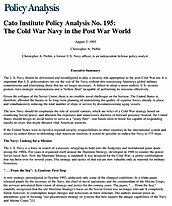Given the collapse of the Soviet Union, there is no credible naval challenger on the horizon. The United States is, therefore, afforded the luxury in its long‐term planning of maintaining the quality of superior forces already in place and simultaneously reducing the total number of ships in service by decommissioning aging vessels.
The new Navy should de‐emphasize the role of aircraft carriers, which are relics of a Cold War strategy based on countering Soviet power, and abandon the expensive and unnecessary doctrine of forward presence. Instead, the United States should design its naval forces to serve as a “ready fleet”–one based close to home but capable of responding rapidly to crises that might threaten vital American interests.
If the United States were to devolve regional security responsibilities to other countries in the international system and restrict its armed forces to defending vital American interests, it would be possible to reduce the Navy to 275 ships.


